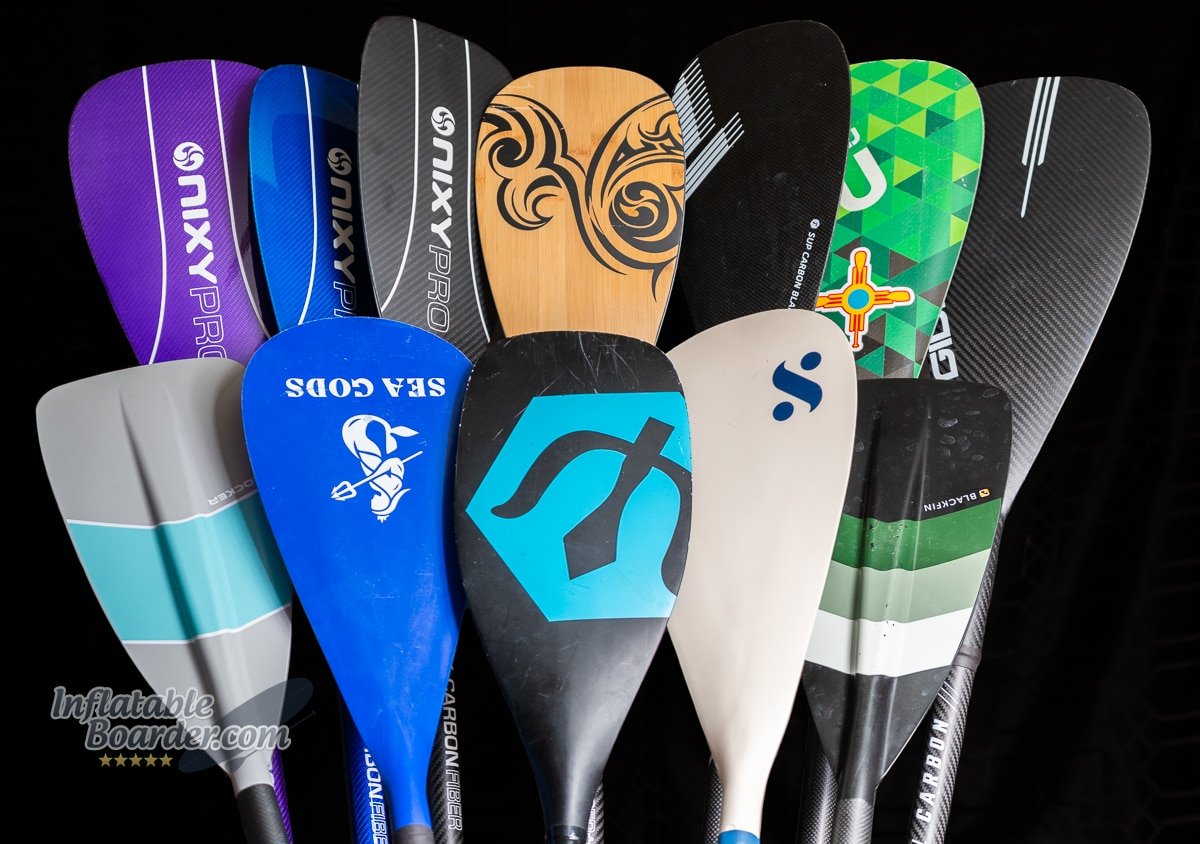
There are nearly as many paddles as paddleboards, and choosing the right one is just as important.
Choosing the right paddle to go with your stand up paddleboard is just as important as choosing your board, and it can be just as daunting to pick the right one. There are hundreds and hundreds of different options available. Trying to decide between them can be difficult – especially if you can’t physically try them first.
This guide is meant to help you evaluate the different materials, sizes, shapes, and other elements that make a SUP paddle to pick the best one for you. We do have a short list of some of our favorite SUP paddles in our Best SUP Paddles list. However, reading this guide first may help make that decision even easier.
Start With You
Before we even begin to get into the paddles, let’s start with you – the paddler. The size and shape of the paddle blade should match your size and how you paddle. Larger paddlers, or those who paddle with lots of equipment on their SUP, will most likely want to have a larger paddle blade instead of a smaller one. Smaller paddlers might want a smaller paddle blade, but also more flex in their paddle. Paddler height and activity will also dictate how long your paddle should be. While single-piece paddles cut to a specific length can offer some of the best performance around, they are an expensive investment to make if you aren’t exactly sure what length you need. We need to explore the ideas of how we are using the paddle before we can really get into choosing the right one.
Now that we’ve looked inward for a starting point, we can begin to evaluate the many different paddle options available.
Set a Budget
Prices constantly change due to material costs, shipping costs, sales, and availability. Knowing how much you want to spend on a new paddle will help narrow down many choices. Stand Up Paddleboard paddles today range from $60 to $600. Like with paddleboards, and pretty much everything else, the cheapest options may not always be the best – or even the least expensive in the long run – and the most expensive options may only be truly useful for the most elite paddlers.
If you are buying your first paddle, or just need a basic replacement for a kit paddle, there are options for even as little as $100 or less. However, spending a little bit more will allow you significantly more options and access to paddles made with better materials and designs. For the serious paddler, a $300 price point will start your journey into the highest quality materials and designs.
For the average paddler who is looking to upgrade from their “kit” paddle, I typically recommend budgeting between $175 and $225 for a high-quality paddle upgrade.
Parts of a SUP Paddle
There aren’t too many parts of a SUP paddle, and not all of them are necessarily important to know in order to have fun on your paddleboard. However, when choosing a new paddle, knowing a few extra details about all of the pieces involved can be helpful in digesting spec sheets and descriptions.
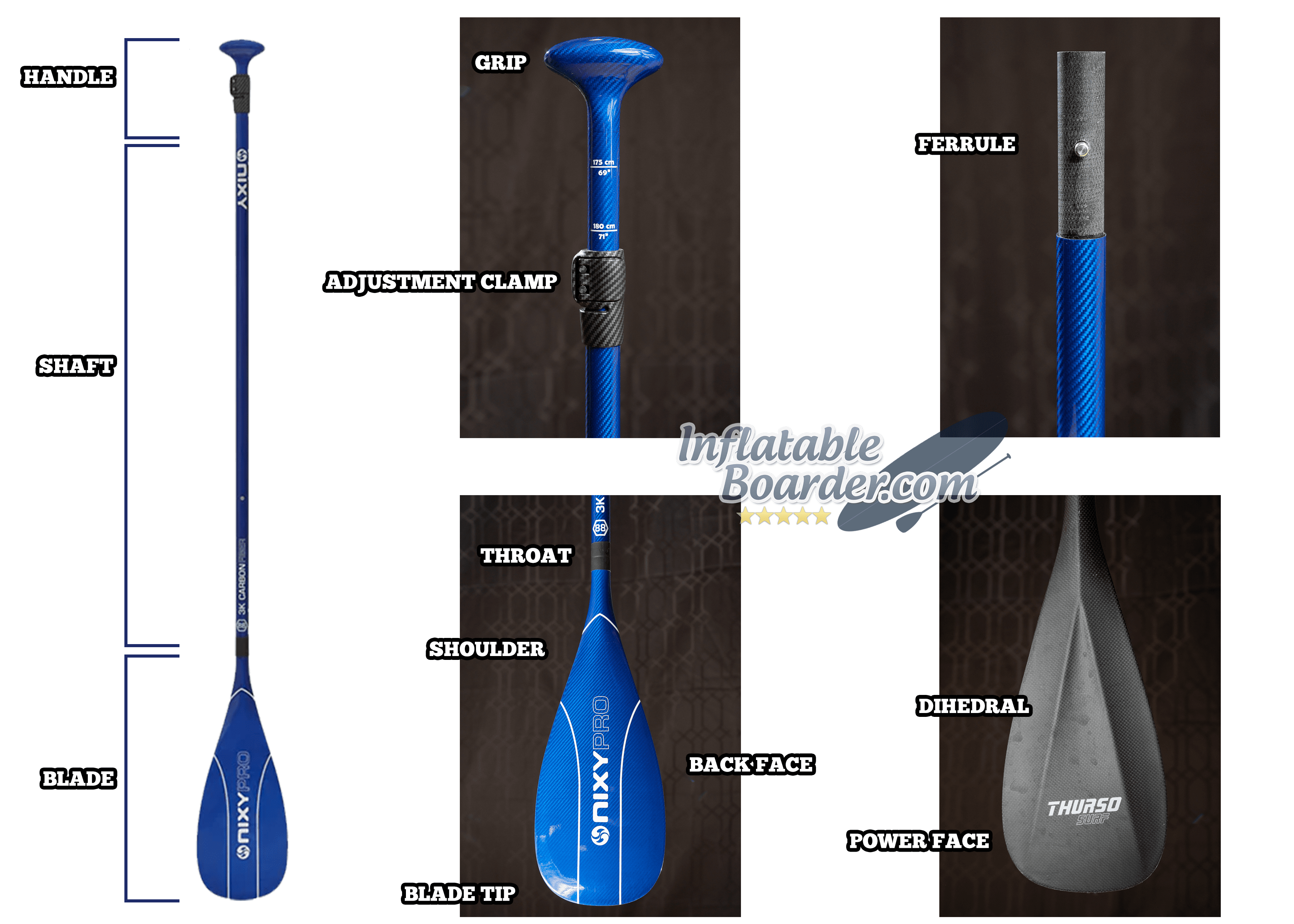
The main parts of a SUP paddle are the blade, shaft and handle, however there are several components to each of those that can change performance and comfort.
Paddle Materials
SUP paddles can be made from any number of different materials including wood, aluminum, plastic, fiberglass, carbon fiber, and more. Each of these materials has its own advantages and disadvantages. They can be blended together or used individually. Below is some general information about some of the more common materials found in SUP paddles
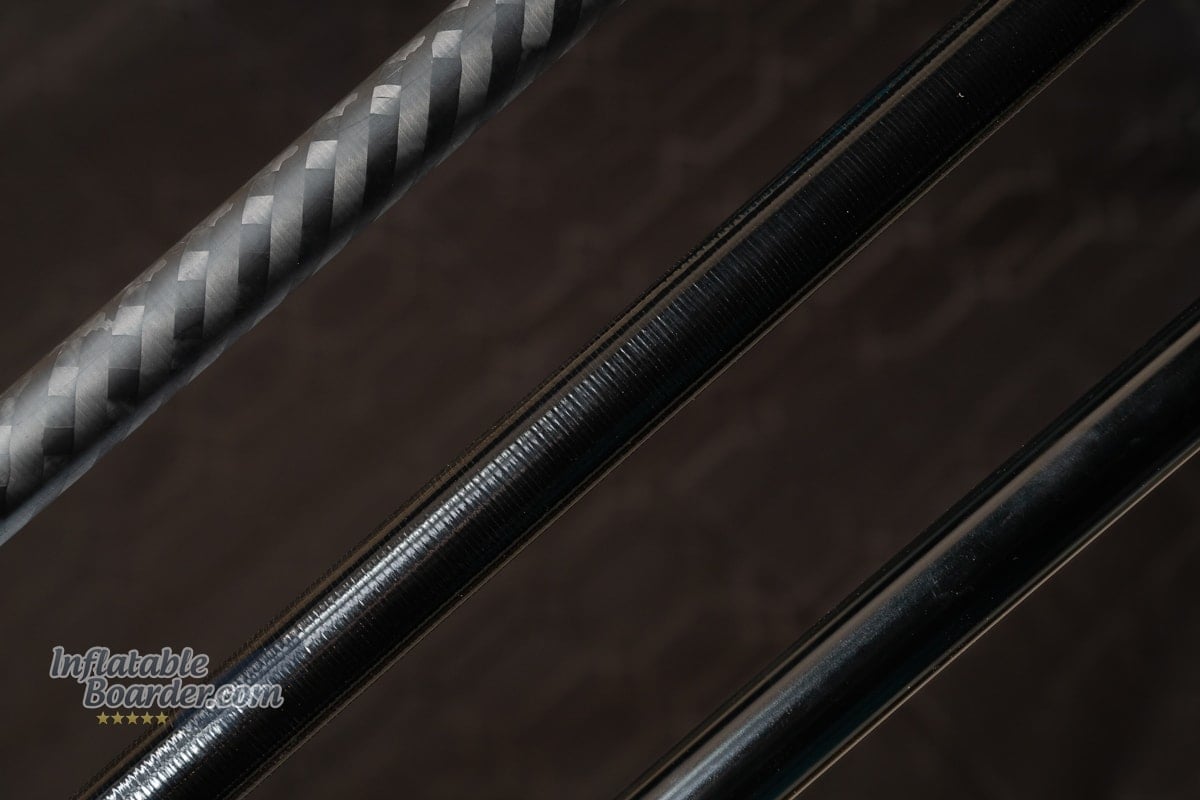
SUP Paddles can be made from many different materials. Carbon Fiber, Fiberglass, and Aluminum are the most common materials for paddle shafts.
Carbon Fiber – strands of carbon fibers, either woven into a fabric or used in individual yarns, held in a matrix of resin. Carbon fiber can be used in any part of a SUP Paddle, but is most commonly used in paddle shafts. Carbon fiber materials are typically very lightweight and stiff, but are more expensive.
Fiberglass – strands of glass fibers, usually woven into a fabric, held in a matrix of resin. Fiberglass can be used in any part of a SUP paddle, but is most commonly used in paddle shafts. Fiberglass materials are lightweight and flexible, and carry a moderate cost.
Carbon Fiber and Fiberglass are referred to as “composite materials” and are often used together in various blends. Not all composite materials are created equally. There are many kinds of composite materials and blends that have different characteristics.
Aluminum – Aluminum tubing is occasionally used to create paddle shafts. Aluminum is heavy and stiff. It is inexpensive, but once bent, it becomes weaker and does not straighten out.
Plastic – Various types of plastics are used primarily in paddle handles and paddle blades. Plastics used in paddle blades are also usually “fiber-reinforced” with pieces of fiberglass, carbon fiber, or other composite fibers embedded in the plastic to add strength and durability.
Wood – Wood can be used in any part of a SUP paddle and in conjunction with composite materials. Depending on the type of wood, construction, and reinforcement/finish wood paddles can be anywhere from light and flexible to heavy and stiff.
Bamboo – Bamboo is a type of grass with a woody stem that is sometimes used as a veneer layer on paddle blades. It does add some weight and rigidity, but is normally not a primary structural layer. Entire pieces of bamboo can also be used as a paddle shaft, however the actual weight, diameter, and performance characteristics of bamboo shafts are highly variable.
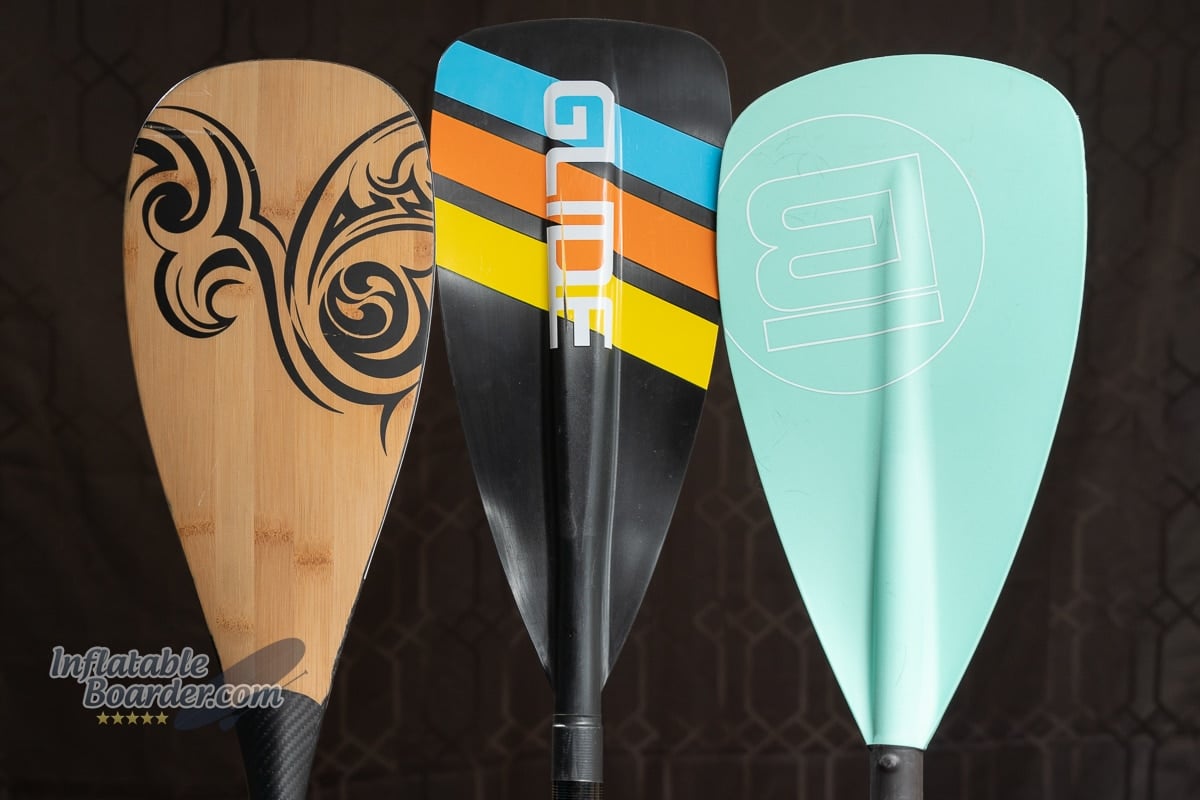
Carbon Fiber, Fiber Reinforced Nylon and ABS Plastic are common materials found in paddle blades. Bamboo is sometimes used as a veneer material for aesthetic purposes.
That lists most of the primary materials used in paddle making. There are always outliers, though, and other materials like Kevlar/aramid, dynel, basalt, and other exotic materials can be used in making paddles, but are not used frequently.
A beginner “kit” paddle that comes with a paddleboard is likely to be made with an aluminum or fiberglass shaft. Some brands are even using fiberglass and carbon fiber blends. Intermediate paddles will be either higher grades of fiberglass, higher grades of fiberglass/carbon fiber blend, or just carbon fiber. The highest performance paddles will use either best available fiberglass/carbon fiber blends or pure carbon fiber.
Similarly, the paddle blades found on basic “kit” paddles are either plastic or fiber-reinforced plastic. Intermediate paddles will have fiberglass or carbon fiber blades with various blends and coatings, and high-performance paddle blades will be made with high-quality carbon fiber.
Not all composite materials are the same. How the individual fibers are grouped and oriented, how the resin is applied, how the tube or blade itself is made, and many other factors impact the weight, stiffness, and strength of a composite product. I will do my best to add clarification wherever possible in this guide to help illustrate those differences.
Sizing a SUP Paddle
Paddle Length
For many paddleboarders, an adjustable paddle offers the ability to pick and choose your paddle length each time you hit the water. This is particularly helpful for newer paddlers, or intermediate paddlers who may want one paddle for multiple types of paddling. Adjustable paddles are heavier than a single piece paddle, and the additional components also create more maintenance points and weak points along the paddle shaft.
While single-piece paddles are lighter and easier to maintain, selecting a paddle height can be daunting. The best way to figure out what paddle length you need is to experiment using an adjustable length paddle. Try shortening or lengthening an inch or two at a time and paddle for a while.
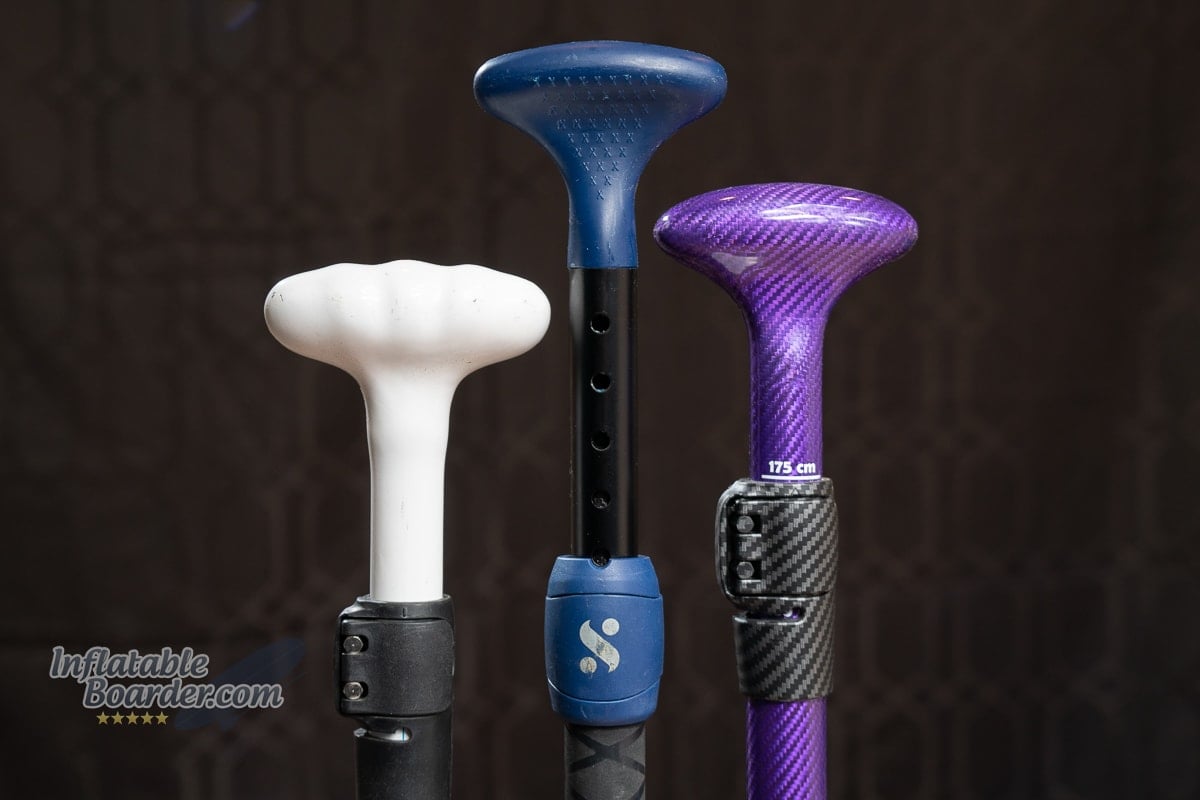
There is no perfect or “correct” paddle length formula. Adjustable-length paddles can help you find out what length you prefer.
Many sources will try to tell you “the formula” for paddle length. They’ll say things like: “your paddle should be 8-10” taller than you,” or “make a shaka sign and put it on your head, that’s the right length,” or “racers should do X, surfers should do Y,” etc.
Here’s the actual secret formula: Choose a paddle length that feels good to you. Don’t be afraid to change your paddle size or use a paddle that’s different from the “rules”!
Those “rules” for paddle length do offer reasonable starting points, but not hard-and-fast rules. Recreational paddlers will typically end up with a paddle that is somewhere around 8-10” longer than their height, but if 11” feels good to you, then that is right for you. If you paddle shallow water frequently, maybe you only need a paddle 6” longer than your height. SUP Surfers, racers, and whitewater paddlers frequently use very short paddles (0-6” longer than their height) as they spend more time squatting lower on their boards.
Here’s the best way to identify your paddle length: Start with one of the general recommendations above and then listen to your body. You shouldn’t have any pain from paddling. If your back hurts while paddling, lengthen your paddle. If your shoulders hurt while paddling, shorten your paddle. If neither your back nor your shoulders hurt and everything feels good, then your paddle is set at a good length!
If you still aren’t sure exactly what length you want, but still want a single-piece paddle, then err on the longer side to start. You can remove the handle, cut the paddle shaft, and replace the handle quite easily on most single-piece paddles. It only takes about 15 minutes and some very simple tools. My first single-piece paddle for racing started at 76” long (7” longer than my height) and is now 72” long.
Paddle Shaft Diameter
Most SUP paddles have paddle shafts with roughly the same diameter – around 1-⅛ inches or 29mm. This diameter fits most paddlers well, and most paddlers don’t spend a lot of time thinking about this specification. However there are several paddles that are available with a “slim” shaft. This is great for paddlers with smaller hands and kids. The smaller shaft can be more comfortable and more secure to hold for people with smaller hands. Smaller diameter shafts also typically have more flex than standard diameter paddle shafts.
Paddle Shaft Flex
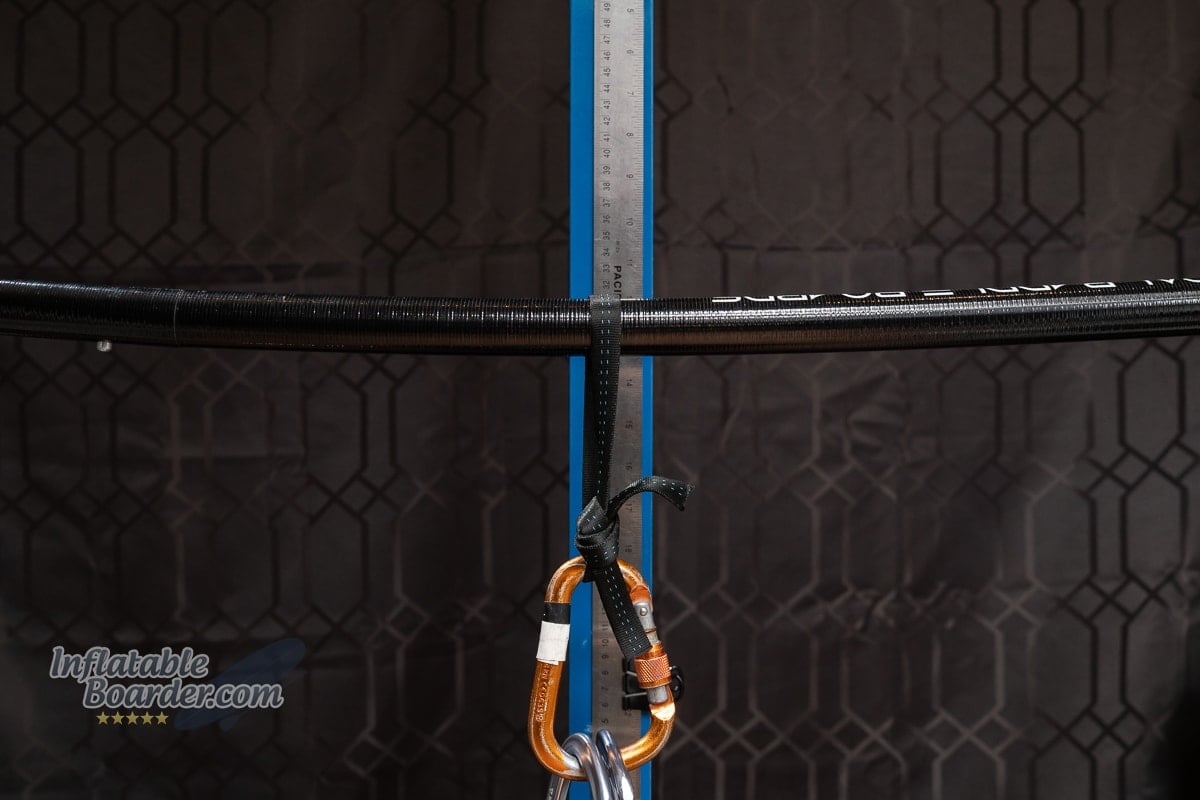
Paddle shaft flex plays an important role in balancing power transfer and comfort
Depending on what materials are used, and in what way they are used, paddle shafts have differing amounts of flex when you use them. Some paddle shafts have more flex for more casual or less-stressful paddling. Others have stiffer paddle shafts for better power transfer. While different materials are typically known for being more flexible or more stiff, that doesn’t always mean that is how they will behave in a paddle. There are fiberglass paddle shafts that are stiffer than carbon fiber paddle shafts (and vice versa). Aluminum and wood can be made into extremely stiff paddle shafts, but when pushed too far may permanently bend or break.
Paddles with more flex will feel softer in the water and easier on your body. Too much flex, though, can make the paddle feel like a wet noodle in terms of power output. On the other end of the spectrum, stiff paddles provide better power transfer and instant feedback to the paddler. If a paddle is too stiff it can become tiring to use or lead to overuse- or even acute-injuries.
For this guide, we used an industry-standard test to determine the amount of flex in each paddle we tested. Each paddle in our test* was suspended across a 150 cm (59”) gap, then bent at the middle with 50 Kg (110 lbs) of weight. The resulting bend is measured in millimeters. Our testing found a range between 40mm (most stiff) and 125mm (most flex). It wasn’t always split along the dividing lines of materials either. There were flexible carbon fiber paddles, and stiff fiberglass paddles. The devil is in the details with paddle shaft stiffness, unfortunately it can be nearly impossible to find the right details when searching for a new paddle.
*A few paddles were not able to be tested because of a too-short fixed length or other factors.
Picking a Paddle Blade
Paddle Blade Size
Choosing the “right” paddle blade size is also going to be a more subjective task than what you were probably hoping for. Like paddle length, the blade size should match what is comfortable for you, but also your size and how you paddle.
SUP Paddle blades typically range in surface area size from about 70 square inches to 105 square inches (450 square cm to 675 square cm). There are no industry-set size descriptions for paddle blades, but for the purposes of this guide:
- XS: 70-75 sq in
- S: 76-81 sq in
- M: 82-87 sq in
- L: 88-95 sq in
- XL: 96+ sq in
Most paddlers will find “medium” or “large” size paddle blades (82-95 square inches) to be comfortable to use across a variety of situations. Paddlers under 140 lbs may find a “small” paddle blade to be more comfortable and efficient to use, while those over 200 lbs can benefit from the larger surface area of an “extra large” size paddle blade with less risk of injury.
Of course there is variability within all of these recommendations and sizes. If you are paddling with heavy loads of equipment (or passengers) regularly, then a larger paddle blade may be a better option for you. The more recent trend in racing is to use smaller blades with a faster cadence. Or if you are a SUP surfer or whitewater paddler, a larger blade size can give you more power with each stroke. If you have had shoulder or back injuries or ailments, then a smaller paddle blade may be more beneficial for you. At 230 lbs, most paddle guides (including this one) recommend I use an XL paddle, but between my paddling style and previous shoulder issues, I personally prefer paddles in the 86-88 square inch size.
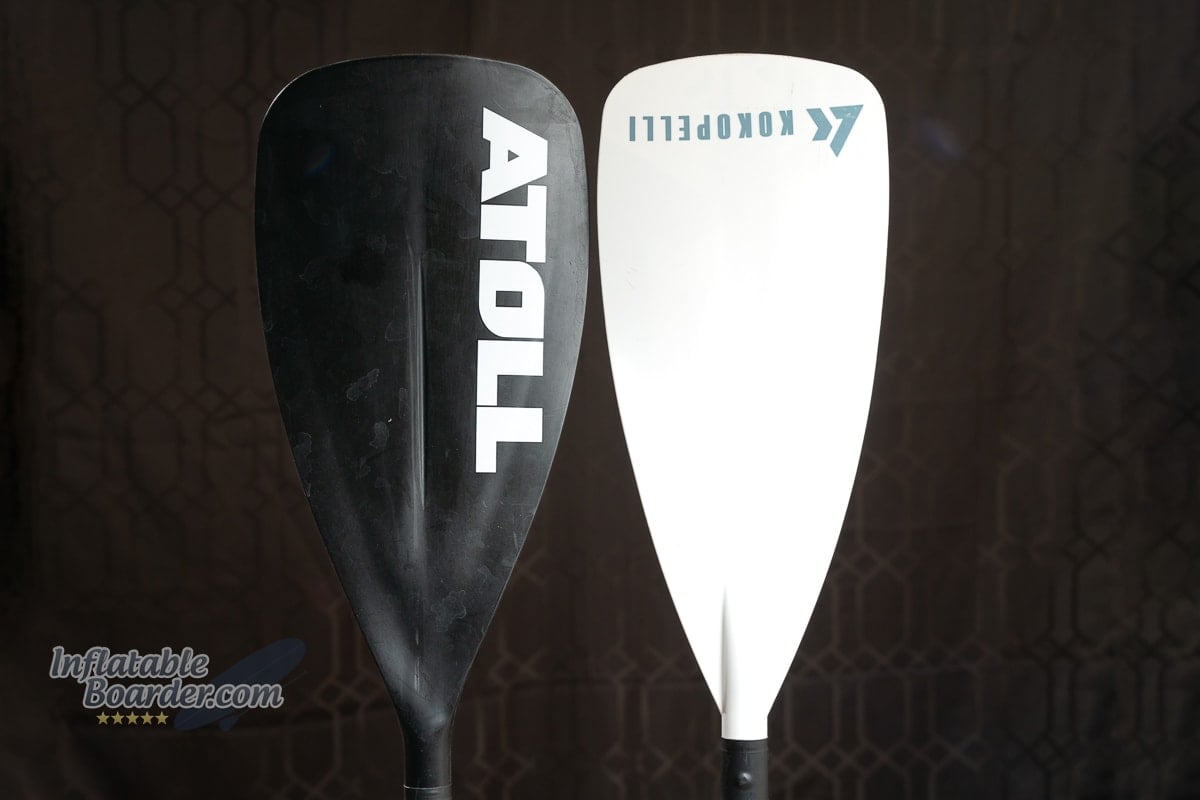
SUP paddle blades come in many different shapes and sizes. It’s important to match the size and shape to you and how you paddle.
Paddle Blade Shape
Now here is where we can start getting into some more concrete ideas for what may or may not work for you based on the type of paddling you do. Blade shape is just as important as any other part of your paddle (and your paddleboard). There are a few key elements to the shape of your paddle blade to know about.
The Aspect of the paddle blade describes its outline or silhouette when looking at the power face of the blade.
High Aspect paddle blades are longer and narrower – typically more of a rectangular shape. These narrower paddle blades move quickly through the water with a consistent feel no matter how far the blade is inserted into the water. For maximum power output you must quickly insert the entire blade length into the water during the first phase of your paddle stroke. High Aspect blades are favored by racers for their high-cadence and by distance paddlers for their efficiency in the water.
Low Aspect paddle blades are shorter and wider – typically more of a teardrop shape. These wider blades have more surface area near the tip of the blade and provide a strong “catch” in the water even before the full length of the blade is in the water. The wider shape is great for taking a few quick, powerful strokes (like when catching a wave), but generally must be paddled with a slower cadence if paddling for longer periods of time. The wider blade is also more prone to fluttering through the paddle stroke if the blade is inserted at an angle, and is more prone to strike the rail of the board during use.
Medium Aspect paddle blades are somewhere in between High and Low aspect blades (helpful, I know). These paddle blades try to balance the advantages and disadvantages of the High and Low aspect blades against each other. Medium aspect blades make good cruising and all-around paddle blades, but do not excel in any one area.
Again, the exact lines between High, Medium, and Low aspect shapes are a little bit subjective, but it is helpful to keep the differences between high and low aspect blades in mind when looking for a new paddle.
Blade Curve refers to how much the paddle blade curves from the throat of the paddle to the tip of the blade. Curving can be done for any number of reasons. In lightweight plastic paddle blades, the blade may have a large amount of curve to counteract the bending force when in use (the paddle gets “straightened out” while in the water). Small amounts of blade curve in composite paddle blades can be used to alter the exact feel of the “catch” phase of the paddle stroke for more immediate traction. Too much blade curve can also cause the paddle to splash and cavitate at the beginning of the stroke and lift water up with the blade at the end of the stroke. Blade curve can also be used to compensate for a lower blade angle. While the spine of the blade may not be greatly angled, a curved blade can provide some of the benefits of a paddle blade with a larger blade angle.
Blade Angle refers to the angle at which the paddle blade is joined to the paddle shaft. Blade angles range from 0° to 12°. Most blades have an angle between 7-10°, but even a few degrees difference in angle can make a big impact on the blade’s performance in the water.
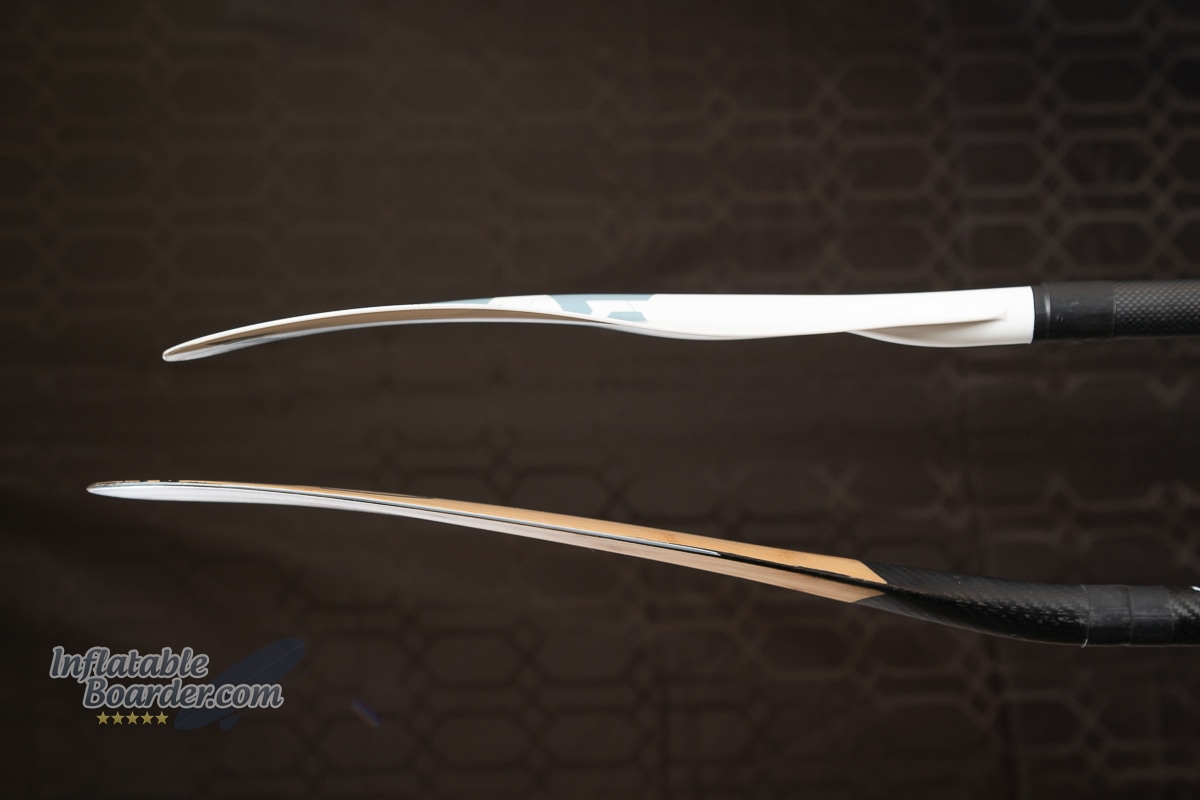
Blade angle and curve greatly impact how a paddle enters the water, how long it produces power, and how cleanly it exits the water at the end of your paddle stroke.
Having the blade angled away from the paddler can do a few things.
First, it can effectively increase the length of the stroke. If the blade angle “elevates” the blade by 4”, then the paddler gets an effective 4” increase in length when reaching forward to start their stroke. The forward blade angle also keeps the paddle in a forward or vertical orientation through a longer part of the paddle stroke. As your board moves past your paddle, a perfectly straight paddle blade will begin to angle back toward the tail of the board causing it to lift and hold onto water as you finish the paddle stroke. A high blade angle can make it difficult to effectively start your paddle stroke, though, and requires more practice to use properly.
A lower blade angle offers some different advantages. Instead of lengthening your stroke, a lower blade angle puts the paddle in a position to provide more power at the start of your paddle stroke. While a lower blade angle reduces the effective length of the stroke, for those paddlers who need immediate power (surfers, whitewater paddlers, sprinters), a lower blade angle can be more beneficial. At the extreme end, a 0° blade angle can be used with either side of the paddle blade. This can be helpful for whitewater paddlers or surfers who want a consistent feel and power no matter which way their blade is oriented.
Dihedral refers to a ridge, or ridges, on the power face of the paddle blade that are used to direct the flow of water. Paddle blades may have no dihedral (the power face is flat), they might have one or two dihedral elements, and those dihedrals may be subtle or very deep. Dihedrals help water flow evenly around the water to reduce blade flutter during the paddle stroke. Double dihedrals offer the same, but also create a pocket in the middle of the paddle to aggressively hold water to increase traction.
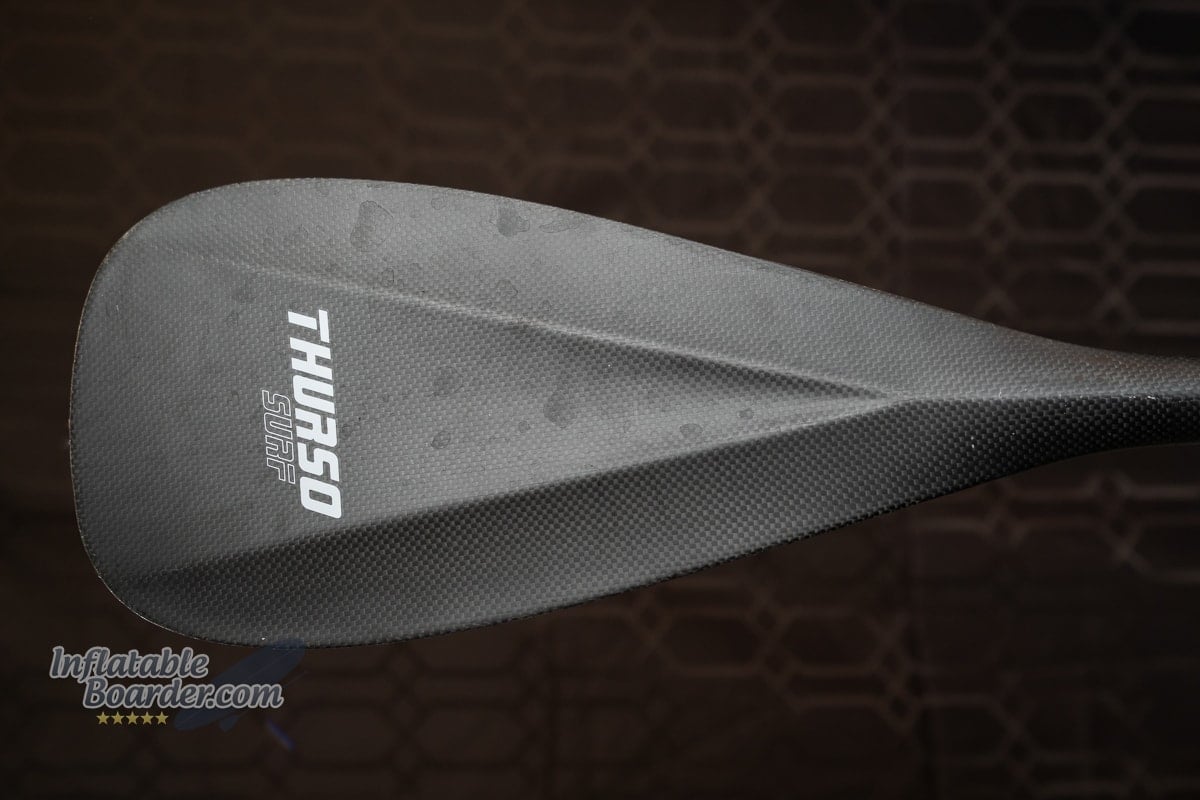
Dihedral ridges direct the flow of water around the sides of the paddle blade. A double dihedral (shown above) creates a pocket on the power face to increase hold and power in the water.
Final Details
Paddle Handles
Let’s move to the other end of the paddle for a moment and talk about the paddle handle. There are two basic types of handles found on SUP paddles. The first, and most common, is the palm grip. This is a roughly triangular shaped handle that will be flat on the back side (for your palm) with an asymmetrical overhang on the front side to allow your fingers to wrap under the grip. Your thumb typically wraps around the back side of the grip and meets with your fingers. Palm grips are comfortable, easily fit most hands (though they can vary in size), and offer a good balance of comfort and control.
The next most common type of handle is the T-grip. T-grips, like their name implies, make a distinct T-shape with a wider, narrow cylinder (or cylinder-like) shape on top of a skinner support (or directly attached to the paddle shaft). T-grips give you more room for your fingers to wrap around the handle and can be held more securely. They also give you a more tactile indication of exactly how the paddle blade is aligned in the water. T-grips focus on control over comfort, but over-gripping them can make the user more prone to blisters.
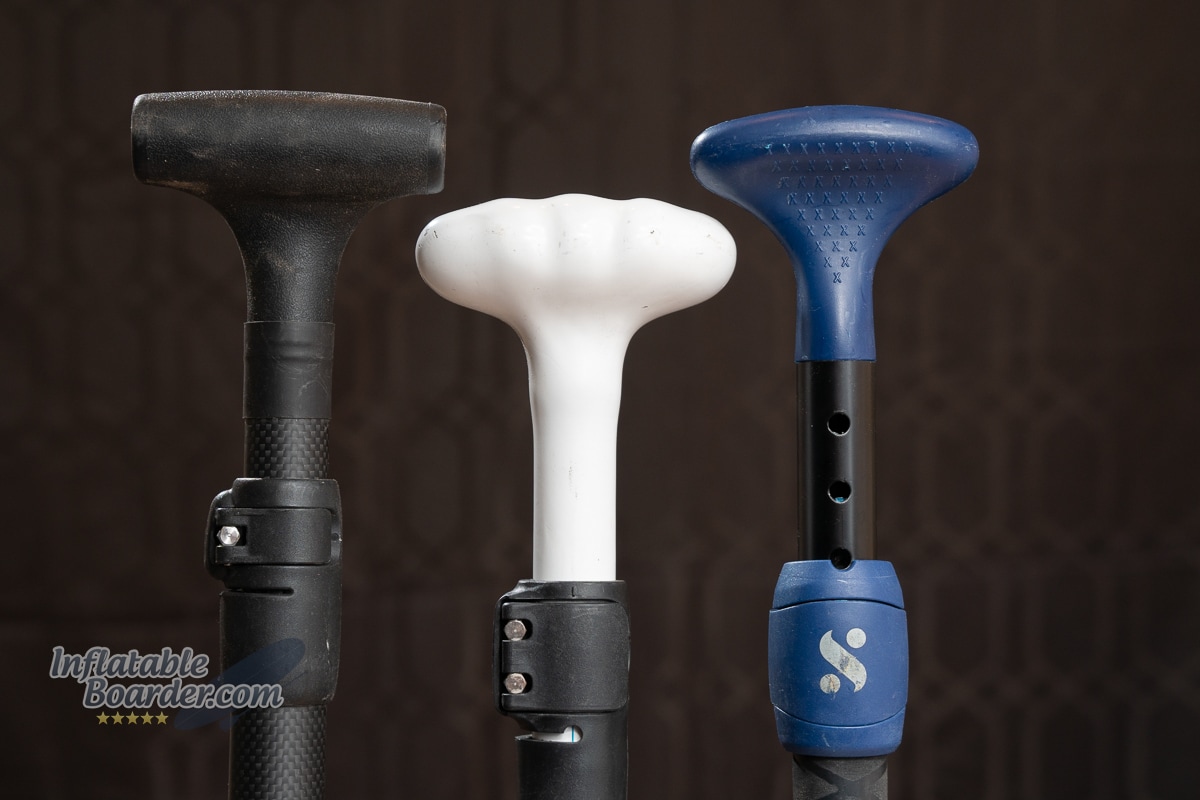
T-Grips (left) and Palm Grips (center and right) are the most common types of grips on SUP paddles. Some paddles use rubber (left), ridges (center), or textures (right) to reduce slipping, but most grips remain smooth.
Fit and Finish
The last thing(s) to consider when selecting a paddle are the Fit and Finish. Fit refers to how well the paddle is physically held together when fully assembled (if a 2+ piece paddle). Single piece paddles won’t have this concern as there are no moving parts. Ferrules, clasps, locks, and indexing marks all work together to determine how solid a multi-piece paddle will feel in your hands. Different brands and different models all treat this… well… differently! Most multi-piece paddles will use a clamping collar or a friction-fit/pin system to allow for handle and length adjustment. These can often be easily adjusted for a tighter or looser clamping pressure to remove any play in the handle. Blade sections usually have a spring pin located in the ferrule that matches with a hole in the paddle shaft. Depending on the manufacturing tolerances of the ferrule and the paddle shaft these can fit very tightly, or can have some degree of play or looseness. Some blade sections will also have a clamping collar to eliminate any play. In a few paddles you can feel this play while paddling and, while still functional, can reduce your paddling efficiency. However this is the exception, not the norm. Sometimes you can find some small amount of play between paddle sections when looking for it by twisting the sections against each other or shaking the paddle vigorously. In most of these cases you may be able to feel movement in your hand, but it’s not detectable at all while paddling. Paddles made with the tightest tolerances and/or with additional features (like an extra clamping collar) will have no play or looseness at all. The fewer sections a paddle has, the easier it is to control and maximize the fit across the whole paddle.
The final touches of a paddle can also be some of the most important touch points for your hands! This includes whether a paddle has a glossy or matte finish, texture left from the manufacturing process, any features to assist in gripping the paddle. Even things as small as weld lines on molded plastic grips can make-or-break the comfort of your paddling experience.
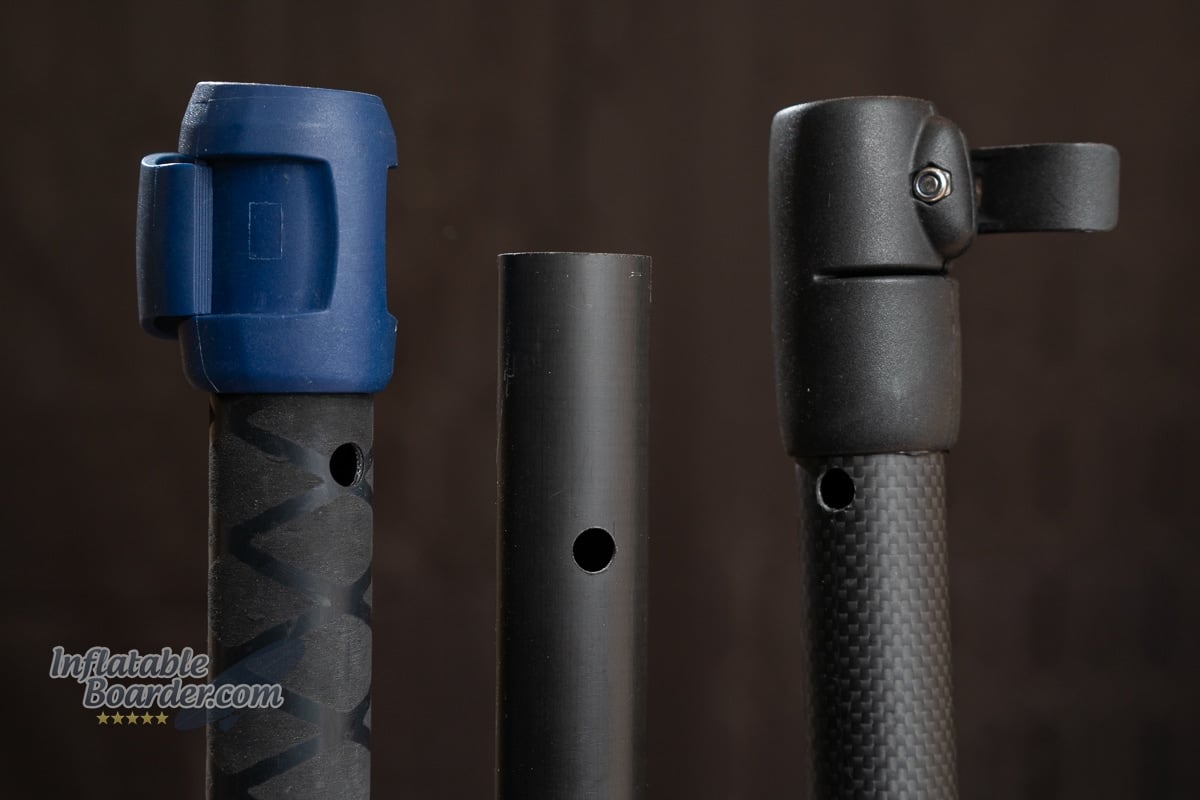
Different paddles use different methods of connecting pieces of a “breakdown” or “travel” paddle.
Final Thoughts
The best way to choose a new SUP paddle is to try as many different paddles as you can get your hands on. This lets you easily compare blade sizes and shapes, flex, weight, grip styles and more. While there is no perfect paddle, there are definitely better paddles. This can be tricky to do if you don’t happen to have multiple (or even one) paddle shop nearby. Ask friends (and strangers!) that you paddle with to try their paddles. Seek out local paddling clubs – they may have loaner equipment or other members can let you try or borrow their own paddles. If you aren’t able to physically get your hands on a paddle to test, start by checking the specs. Look for the materials, surface area, shapes, and any other data you can. Of course, look for first-hand reviews of different paddles as well. Our Best SUP Paddles list includes many different types of Kit and Stand-Alone paddles that we have personally used and tested. We’ve tested over 30 different paddles and will continue to add to our database as we get new paddles for review in the future. Check out our in-depth SUP Paddle Comparison Chart (pdf).
One thing that I do stress to people asking for paddle advice is: If you are looking to upgrade to a better paddle for longer distances, faster paddling, or changing the physical characteristics to be better for your style of paddling, it’s important to set a realistic budget for your needs. While you can get replacement kit paddles and very basic aluminum/plastic paddles for as little as $60, the cheaper the price, the cheaper the paddle will be with materials, construction, and performance. Anyone looking to upgrade from a kit paddle should expect to spend between $175 and $300 depending on the exact features. Hardcore paddlers looking for the lightest, stiffest, or any other “-est” paddles should get ready for price tags from $400-650. The DIY enthusiast can also venture into the depths of making your own SUP paddles for a truly unique and rewarding experience.
Choosing a SUP Paddle FAQ
What makes a better paddle, Carbon Fiber, Fiberglass, or Aluminum?
Each material has its own advantages and disadvantages. Composite materials (like carbon fiber or fiberglass) are nearly universally “better” for SUP paddles than aluminum. They are lighter, more durable, and can be tuned to offer exact performance characteristics. Carbon Fiber is not inherently better than Fiberglass. Which versions of those materials, how they are made, and how they are put together make a big difference. One of the highest-rated racing paddles among professional SUP athletes uses a shaft that is actually made with a blend of carbon fiber, fiberglass, and aluminum!
Should I get a Teardrop shape or Rectangular shape paddle blade?
Teardrop shape (low aspect) paddle blades are made to be used at a slower cadence (or for only a few quick strokes) and the tip of the blade carries most of the surface area, so even if the entire blade is not in the water it still has a good hold. Rectangular blades are made for faster paddling cadences and for more efficient paddling over long distances. Adjusting the depth of the paddle blade in the water has a greater impact on the amount of force the paddle produces.
What Length SUP Paddle do I need?
Length is determined by what kind of paddling you are doing, your size, your body mechanics, and much more. There is no exact size recommendation based on height, but there are good starting points. Recreational paddlers will typically find that a paddle 8-10” longer than their height is a good starting point. If the paddle blade isn’t getting all the way in the water, or your back is hurting, lengthen it. If the paddle blade is going too deep (past the throat) or your shoulders are hurting, then shorten the paddle. Surfers, Racers, and Whitewater paddlers tend to favor shorter paddles (0-6”) as their stance is normally lower to the surface of the water.
Should I get a 1 piece, 2 piece, or 3+ piece SUP Paddle?
Single piece paddles will generally be lighter and stiffer than multi-piece paddles, but that will depend on the exact materials and construction. There are high-end 3-piece travel paddles that are lighter and stiffer than some lower or mid-tier single piece paddles. The biggest downside to a single piece paddle is the set length. You have to pick a length and that’s it. While they can normally be shortened, they can’t be lengthened. Most recreational and intermediate paddlers can get most of the benefits of a single piece paddle, but with adjustability by using a 2 piece paddle. However this still requires a larger amount of room to transport and store compared to 3+ piece paddles.



Leave a Reply